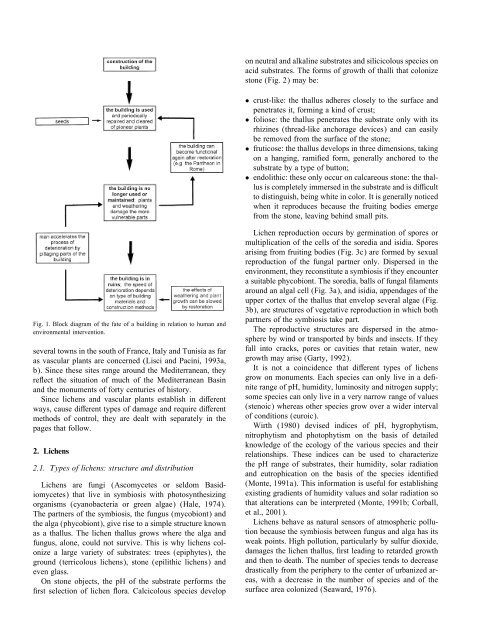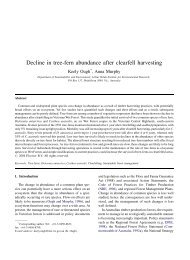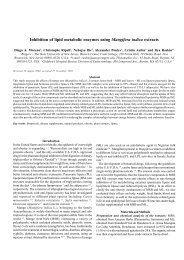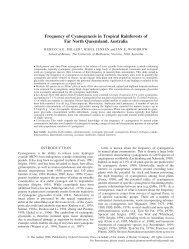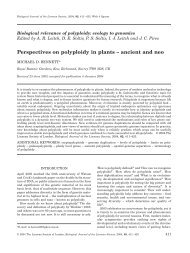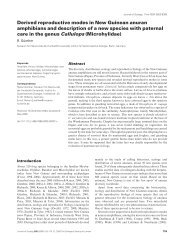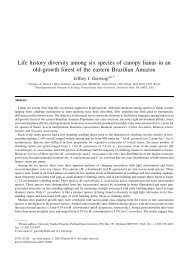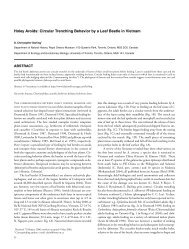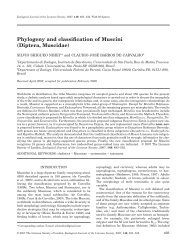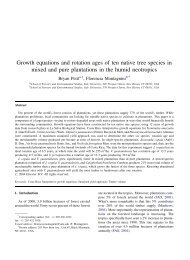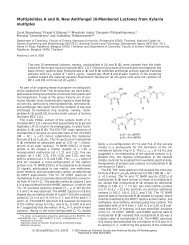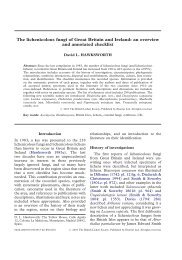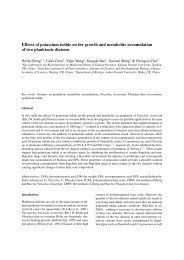Lichens and higher plants on stone: a review - AseanBiodiversity.info
Lichens and higher plants on stone: a review - AseanBiodiversity.info
Lichens and higher plants on stone: a review - AseanBiodiversity.info
Create successful ePaper yourself
Turn your PDF publications into a flip-book with our unique Google optimized e-Paper software.
Fig. 1. Block diagram of the fate of a building in relati<strong>on</strong> to human <str<strong>on</strong>g>and</str<strong>on</strong>g><br />
envir<strong>on</strong>mental interventi<strong>on</strong>.<br />
several towns in the south of France, Italy <str<strong>on</strong>g>and</str<strong>on</strong>g> Tunisia as far<br />
as vascular <str<strong>on</strong>g>plants</str<strong>on</strong>g> are c<strong>on</strong>cerned (Lisci <str<strong>on</strong>g>and</str<strong>on</strong>g> Pacini, 1993a,<br />
b). Since these sites range around the Mediterranean, they<br />
re ect the situati<strong>on</strong> of much of the Mediterranean Basin<br />
<str<strong>on</strong>g>and</str<strong>on</strong>g> the m<strong>on</strong>uments of forty centuries of history.<br />
Since lichens <str<strong>on</strong>g>and</str<strong>on</strong>g> vascular <str<strong>on</strong>g>plants</str<strong>on</strong>g> establish in di erent<br />
ways, cause di erent types of damage <str<strong>on</strong>g>and</str<strong>on</strong>g> require di erent<br />
methods of c<strong>on</strong>trol, they are dealt with separately in the<br />
pages that follow.<br />
2. <str<strong>on</strong>g>Lichens</str<strong>on</strong>g><br />
2.1. Types of lichens: structure <str<strong>on</strong>g>and</str<strong>on</strong>g> distributi<strong>on</strong><br />
<str<strong>on</strong>g>Lichens</str<strong>on</strong>g> are fungi (Ascomycetes or seldom Basidiomycetes)<br />
that live in symbiosis with photosynthesizing<br />
organisms (cyanobacteria or green algae) (Hale, 1974).<br />
The partners of the symbiosis, the fungus (mycobi<strong>on</strong>t) <str<strong>on</strong>g>and</str<strong>on</strong>g><br />
the alga (phycobi<strong>on</strong>t), give rise to a simple structure known<br />
as a thallus. The lichen thallus grows where the alga <str<strong>on</strong>g>and</str<strong>on</strong>g><br />
fungus, al<strong>on</strong>e, could not survive. This is why lichens col<strong>on</strong>ize<br />
a large variety of substrates: trees (epiphytes), the<br />
ground (terricolous lichens), st<strong>on</strong>e (epilithic lichens) <str<strong>on</strong>g>and</str<strong>on</strong>g><br />
even glass.<br />
On st<strong>on</strong>e objects, the pH of the substrate performs the<br />
rst selecti<strong>on</strong> of lichen ora. Calcicolous species develop<br />
<strong>on</strong> neutral <str<strong>on</strong>g>and</str<strong>on</strong>g> alkaline substrates <str<strong>on</strong>g>and</str<strong>on</strong>g> silicicolous species <strong>on</strong><br />
acid substrates. The forms of growth of thalli that col<strong>on</strong>ize<br />
st<strong>on</strong>e (Fig. 2) may be:<br />
• crust-like: the thallus adheres closely to the surface <str<strong>on</strong>g>and</str<strong>on</strong>g><br />
penetrates it, forming a kind of crust;<br />
• foliose: the thallus penetrates the substrate <strong>on</strong>ly with its<br />
rhizines (thread-like anchorage devices) <str<strong>on</strong>g>and</str<strong>on</strong>g> can easily<br />
be removed from the surface of the st<strong>on</strong>e;<br />
• fruticose: the thallus develops in three dimensi<strong>on</strong>s, taking<br />
<strong>on</strong> a hanging, rami ed form, generally anchored to the<br />
substrate by a type of butt<strong>on</strong>;<br />
• endolithic: these <strong>on</strong>ly occur <strong>on</strong> calcareous st<strong>on</strong>e: the thallus<br />
is completely immersed in the substrate <str<strong>on</strong>g>and</str<strong>on</strong>g> is di cult<br />
to distinguish, being white in color. It is generally noticed<br />
when it reproduces because the fruiting bodies emerge<br />
from the st<strong>on</strong>e, leaving behind small pits.<br />
Lichen reproducti<strong>on</strong> occurs by germinati<strong>on</strong> of spores or<br />
multiplicati<strong>on</strong> of the cells of the soredia <str<strong>on</strong>g>and</str<strong>on</strong>g> isidia. Spores<br />
arising from fruiting bodies (Fig. 3c) are formed by sexual<br />
reproducti<strong>on</strong> of the fungal partner <strong>on</strong>ly. Dispersed in the<br />
envir<strong>on</strong>ment, they rec<strong>on</strong>stitute a symbiosis if they encounter<br />
a suitable phycobi<strong>on</strong>t. The soredia, balls of fungal laments<br />
around an algal cell (Fig. 3a), <str<strong>on</strong>g>and</str<strong>on</strong>g> isidia, appendages of the<br />
upper cortex of the thallus that envelop several algae (Fig.<br />
3b), are structures of vegetative reproducti<strong>on</strong> in which both<br />
partners of the symbiosis take part.<br />
The reproductive structures are dispersed in the atmosphere<br />
by wind or transported by birds <str<strong>on</strong>g>and</str<strong>on</strong>g> insects. If they<br />
fall into cracks, pores or cavities that retain water, new<br />
growthmay arise (Garty, 1992).<br />
It is not a coincidence that di erent types of lichens<br />
grow <strong>on</strong> m<strong>on</strong>uments. Eachspecies can <strong>on</strong>ly live in a de -<br />
nite range of pH, humidity, luminosity <str<strong>on</strong>g>and</str<strong>on</strong>g> nitrogen supply;<br />
some species can <strong>on</strong>ly live in a very narrow range of values<br />
(stenoic) whereas other species grow over a wider interval<br />
of c<strong>on</strong>diti<strong>on</strong>s (euroic).<br />
Wirth (1980) devised indices of pH, hygrophytism,<br />
nitrophytism <str<strong>on</strong>g>and</str<strong>on</strong>g> photophytism <strong>on</strong> the basis of detailed<br />
knowledge of the ecology of the various species <str<strong>on</strong>g>and</str<strong>on</strong>g> their<br />
relati<strong>on</strong>ships. These indices can be used to characterize<br />
the pH range of substrates, their humidity, solar radiati<strong>on</strong><br />
<str<strong>on</strong>g>and</str<strong>on</strong>g> eutrophicati<strong>on</strong> <strong>on</strong> the basis of the species identi ed<br />
(M<strong>on</strong>te, 1991a). This <strong>info</strong>rmati<strong>on</strong> is useful for establishing<br />
existing gradients of humidity values <str<strong>on</strong>g>and</str<strong>on</strong>g> solar radiati<strong>on</strong> so<br />
that alterati<strong>on</strong>s can be interpreted (M<strong>on</strong>te, 1991b; Corball,<br />
et al., 2001).<br />
<str<strong>on</strong>g>Lichens</str<strong>on</strong>g> behave as natural sensors of atmospheric polluti<strong>on</strong><br />
because the symbiosis between fungus <str<strong>on</strong>g>and</str<strong>on</strong>g> alga has its<br />
weak points. Highpolluti<strong>on</strong>, particularly by sulfur dioxide,<br />
damages the lichen thallus, rst leading to retarded growth<br />
<str<strong>on</strong>g>and</str<strong>on</strong>g> then to death. The number of species tends to decrease<br />
drastically from the periphery to the center of urbanized areas,<br />
with a decrease in the number of species <str<strong>on</strong>g>and</str<strong>on</strong>g> of the<br />
surface area col<strong>on</strong>ized (Seaward, 1976).


